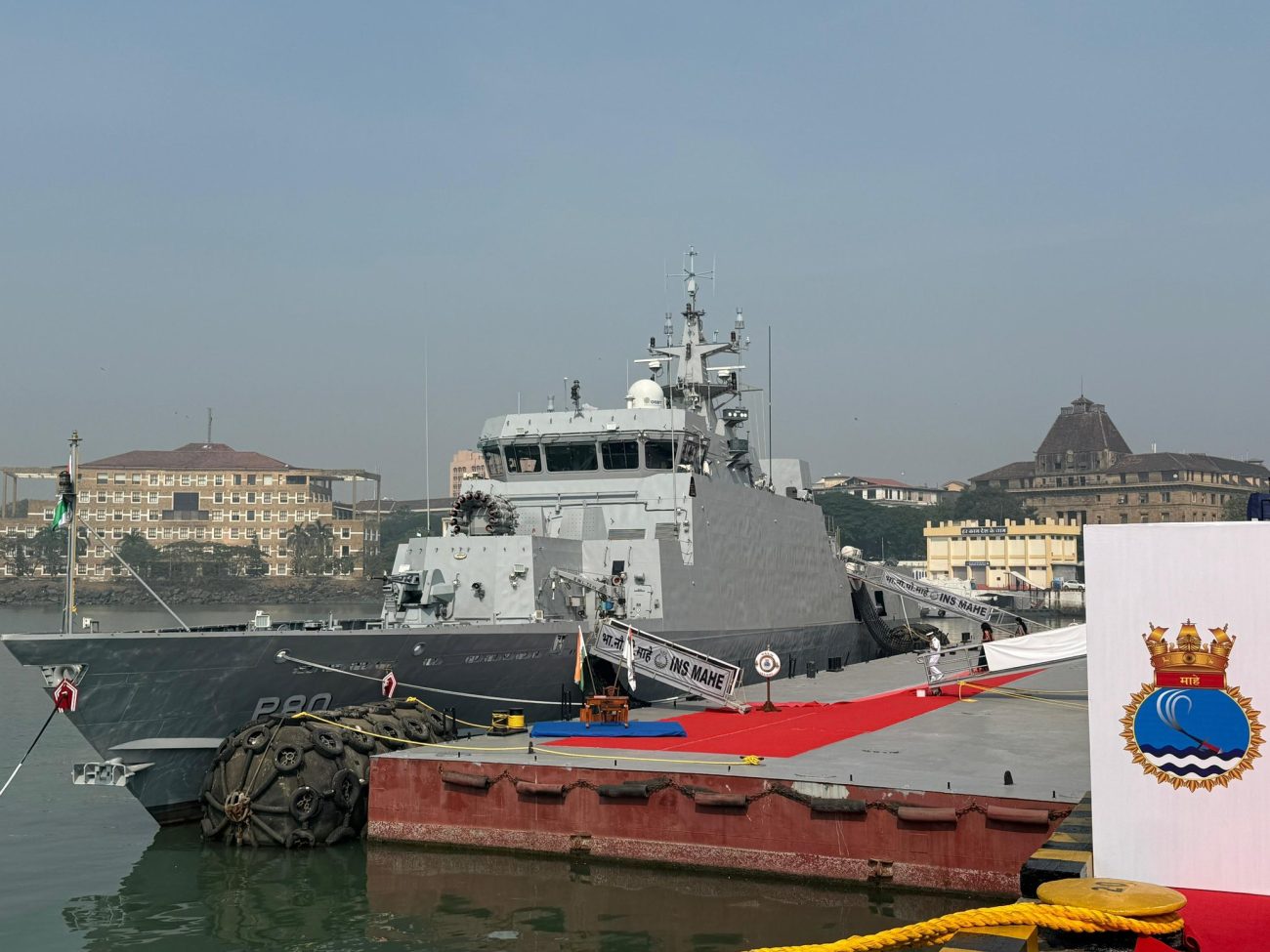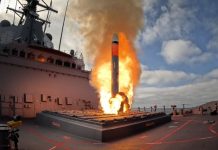INS Mahe, the first vessel in the Mahe class of shallow water anti-submarine warfare ships, joined the Indian Navy today at the Naval Dockyard in Mumbai.
The ship is built by Cochin Shipyard and marks an important addition to the Navy’s efforts to strengthen its presence in coastal waters.
The event, hosted by V.Adm Krishna Swaminathan, Flag Officer Commanding-in-Chief, Western Naval Command, was presided over by General Upendra Dwivedi, Chief of the Army Staff (COAS), with senior naval officers and representatives from Cochin Shipyard Ltd, Kochi.
This landmark moment reflects unprecedented synergy, mutual trust, and seamless jointness shaping today’s Indian Armed Forces. A powerful symbol of how our services stand together, think together, and move together towards a future-ready, fully integrated force.
The Western Naval Command described the new ship as a key asset for future security needs, especially in the growing challenge of tracking hostile submarines close to shore.
INS Mahe carries the motto ‘Silent Hunters’, which highlights the qualities that define anti-submarine operations: quiet movement, sharp awareness, and firm action when required.
Features Of INS Mahe
INS Mahe is about 78 meters long, weighs roughly 1,150 tonnes, and can reach speeds of up to 25 knots. The ship can accommodate more than 80 personnel and is powered by three main engines, each producing 4,000 kilowatts.
INS Mahe stands as a shining symbol of Aatmanirbhar Bharat. With over 80% indigenous content, the ship underscores the Indian Navy’s sustained efforts to promote indigenisation through homegrown solutions and innovative technologies.
Drawing on the expertise of BEL, L&T Defence, Mahindra Defence Systems, NPOL, and more than 20 MSMEs, the project reinforces India’s expanding ecosystem of naval design, equipment, and system integration.
The vessel carries a mix of advanced sonar, lightweight torpedoes, anti-submarine rockets, an active torpedo decoy system, and a stabilised remote-controlled gun. Most of these systems are manufactured in India, which enhances the ship’s reliability and ease of support.
Fitted with advanced weapons, sensors, and communication systems enabling it to detect, track, and neutralise sub-surface threats with precision, the ship can sustain prolonged operations in shallow waters and features technologically advanced machinery and control systems.
Its design allows it to handle a range of tasks, including anti-submarine warfare, coastal patrols, underwater surveillance, low-intensity missions, and even mine-laying when required.
Its primary job will be to protect key sea routes and respond quickly to submarine activity near the coast.

Why the Navy Needs Shallow Water Warships?
The Navy has long operated capable deep-sea platforms for hunting submarines, but it lacked ships designed specifically for shallow waters, where the depth can fall to about 30 meters or less. These coastal zones extend nearly 12 nautical miles from the shore and are often the hardest places to track a submarine.
To address this, the Ministry of Defence approved a plan for 16 shallow-water ASW vessels. The Defence Acquisition Council cleared the proposal in December 2013 to replace the ageing Abhay-class corvettes, which entered service between 1989 and 1991. The last ship of this class, INS Abhay, was decommissioned on 6 October 2025.
A tender worth about $2.25 billion was issued in June 2014 under the Buy and Make India category. It went out to several private shipyards, including L&T, ABG Shipyard, Pipavav, Goa Shipyard, and GRSE. In October 2017, Cochin Shipyard and GRSE emerged as the lowest bidders, with both yards selected to build the ships.
Under the division of work, GRSE in Kolkata is building eight vessels, and Cochin Shipyard is building the other eight. All sixteen ships are named after Indian islands beginning with either A or M.
GRSE is responsible for the A-named ships, which will join the Eastern Naval Command, while CSL is building the M-named ships for the Western Naval Command.
India’s ASW-SWC Fleet
Cochin Shipyard began work on the project on 1 December 2020, when it cut steel for the first vessel in the ASW-SWC series, Mahe (BY 523), in Kochi. Five years later, on 23 October 2025, the lead ship was handed over to the Indian Navy, marking a major milestone for the programme.
Along with INS Mahe, the class will eventually include Malwan, Mangrol, Malpe, Magdala, and Machilipatnam.
The Navy has been steadily expanding its fleet of shallow-water anti-submarine craft to improve surveillance and strengthen its ability to counter underwater threats.
Of the eight ships being built by GRSE, two are already serving with the Eastern Naval Command.
INS Arnala was commissioned on 18 June 2025 and became the first of its class to join the fleet. INS Androth, the second in the series, was commissioned on 6 October 2025 in Visakhapatnam.
GRSE also launched Ajay, the eighth and final vessel in the ASW Shallow Water Craft programme, on 21 July 2025.
Apart from Arnala, Androth, and Ajay, the Arnala class includes Anjadip, Amini, Abhay, Agray, and Akshay, which are still under construction.
History & Transition to ASW-SWC
As India’s maritime environment evolved. The nature of threats in the littorals shifted from mines to stealthy, diesel-electric submarines capable of hiding in shallow, acoustically complex waters.
The older Abhay-class corvettes, originally adapted ASW platforms derived from the Pauk-class, provided an important bridge in capability but were limited by their propeller-driven design, acoustic signature, and legacy systems. The Navy recognised the need for a new class of ships purpose-built for high-speed, low-noise anti-submarine warfare in the littorals.
This requirement gave rise to the ASW-Shallow Water Craft (ASW-SWC) programme, a clean-sheet Indian design tailored specifically for coastal ASW tasks, unlike the Abhay class, which was based on an existing Soviet design.
The new craft incorporates waterjet propulsion, indigenous sensors, digital combat systems, and automation, enabling them to hunt submarines in areas where larger corvettes struggle to manoeuvre. The shift represents a deliberate move from adapting existing hulls to developing specialised, custom-built littoral combatants.
The transition from Abhay-class corvettes to ASW-SWC marks a doctrinal evolution, from multipurpose ASW ships operating in deeper waters to dedicated shallow-water hunters forming a persistent underwater watch along the coast.
With advanced sonar such as Abhay, torpedo, and rocket-based strike systems, low signatures, and networked design, the ASW-SWCs for coastal security embody the Navy’s modern approach, speed, stealth, digital integration, and emphasis on indigenous capability.
The City Of Mahe
The ship takes its name from Mahe, a quiet coastal town on the Malabar coast. Mahe sits at the mouth of the Mayyazhi River and is part of the Union Territory of Puducherry, though it is completely surrounded by Kerala’s Kannur and Kozhikode districts.
The town has a long history as a trading hub and was once a French settlement, which has shaped much of its character. Its links to the sea run deep, and its culture reflects generations of coastal life, maritime travel, and local resilience.
Naming the ship after Mahe is a nod to those traditions. It connects the vessel to a place known for its calm shores, strong heritage and steady relationship with the sea. It is a fitting name for a warship built to protect the coastline with quiet efficiency and steady strength.
Crest & Symbolism
The ship’s crest features the Urumi, a flexible whip sword used in Kalaripayattu, Kerala’s ancient martial art. The weapon is known for its speed, control, and fluid movement, qualities the Navy wanted to reflect in the ship’s role.
In the crest, the Urumi rises from the sea, suggesting the ship’s ability to move quickly in tight waters and strike with accuracy when needed. The waves around it represent the country’s long coastline and the Navy’s constant watch over it.
The Navy says the crest blends cultural heritage with modern capability and reflects its broader push toward homegrown technology and greater self-reliance.
Legacy Of The Old Mahe
The legacy of the name ‘Mahe’ in the Indian Navy began with INS Mahe (M 83). A Soviet-built coastal minesweeper that entered service in 1983, when inshore mine countermeasure capability was critical for securing ports and harbour approaches.
Commissioned at Kochi, she became a familiar presence under the Southern Naval Command, performing essential duties in harbour clearance, coastal patrols, and safety assurance during both routine operations and periods of heightened readiness. Though modest in size, the ship contributed significantly to maritime safety along the western seaboard.
Designed for inshore minesweeping, she undertook harbour approach sanitisation and coastal patrols, supporting the Navy’s effort to maintain safe access to ports and detect underwater hazards in an era shaped by evolving coastal threats.
After 24 years of dedicated service, INS Mahe was decommissioned in 2006 at her pay-off ceremony, honouring a vessel known for reliability, professionalism, and steadfast coastal vigilance.
The commissioning of the new INS Mahe today revives this historic name, carrying forward a legacy of silent service and enduring connection to India’s western coastline.
- Shubhangi Palve is a defense and aerospace journalist. Before joining the EurAsian Times, she worked for ET Prime. She has over 15 years of extensive experience in the media industry, spanning print, electronic, and online domains.
- Contact the author at shubhapalve (at) gmail.com




